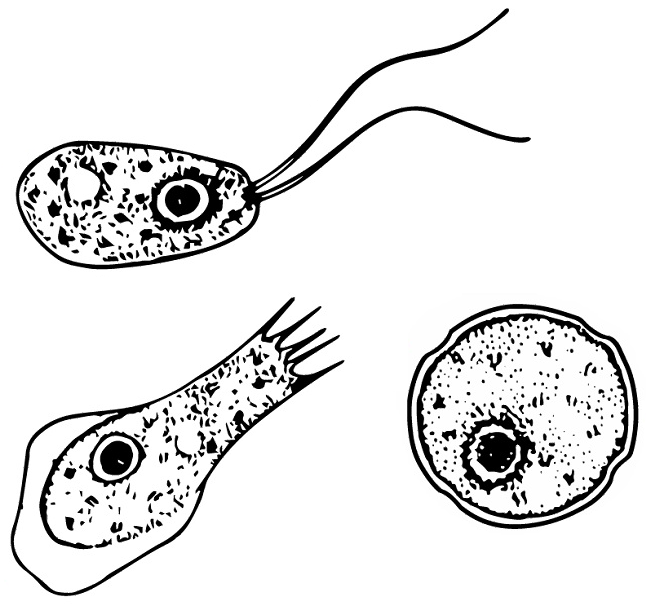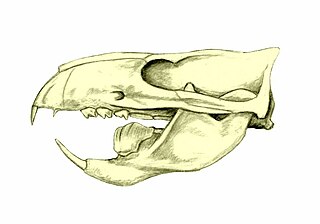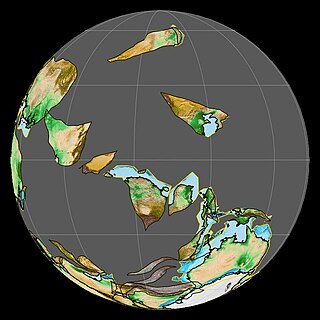
The Percolozoa are a group of colourless, non-photosynthetic Excavata, including many that can transform between amoeboid, flagellate, and cyst stages.

The Poeciliidae are a family of freshwater fishes of the order Cyprinodontiformes, the tooth-carps, and include well-known live-bearing aquarium fish, such as the guppy, molly, platy, and swordtail. The original distribution of the family was the Southeastern United States to north of Río de la Plata, Argentina, and Africa, including Madagascar. Due to release of aquarium specimens and the widespread use of species of the genera Poecilia and Gambusia for mosquito control, though, poeciliids can today be found in all tropical and subtropical areas of the world. In addition, Poecilia and Gambusia specimens have been identified in hot springs pools as far north as Banff, Alberta.

In taxonomy, binomial nomenclature, also called binominal nomenclature or binary nomenclature, is a formal system of naming species of living things by giving each a name composed of two parts, both of which use Latin grammatical forms, although they can be based on words from other languages. Such a name is called a binomial name, a binomen, binominal name or a scientific name; more informally it is also called a Latin name.

Trypanosomatida is a group of kinetoplastid excavates distinguished by having only a single flagellum. The name is derived from the Greek trypano (borer) and soma (body) because of the corkscrew-like motion of some trypanosomatid species. All members are exclusively parasitic, found primarily in insects. A few genera have life-cycles involving a secondary host, which may be a vertebrate, invertebrate or plant. These include several species that cause major diseases in humans.

Ptilodus is a genus of mammals from the extinct order of Multituberculata, and lived during the Paleocene in North America.

Monogeneans are a group of ectoparasitic flatworms commonly found on the skin, gills, or fins of fish. They have a direct lifecycle and do not require an intermediate host. Adults are hermaphrodites, meaning they have both male and female reproductive structures.

The Japanese spider crab is a species of marine crab that lives in the waters around Japan. It has the largest leg span of any arthropod. They go through three main larval stages along with a prezoeal stage in order to grow to their great size. The genus Macrocheira contains multiple species. Two fossil species of this genus have been found, Macrocheira ginzanensis and Macrocheira yabei, both from the Miocene of Japan. The diverse taxonomic history is an important part of what these creatures are and how they evolved to be what they are today. These creatures are not isolated however, as they are the subject of fishery and are considered a delicacy. Conservation efforts are being put forth to protect these creatures and their population from the dangers of overfishing.

Snakeflies are a group of predatory insects comprising the order Raphidioptera with two extant families: Raphidiidae and Inocelliidae, consisting of roughly 260 species. In the past, the group had a much wider distribution than it does now; snakeflies are found in temperate regions worldwide but are absent from the tropics and the southern hemisphere. They are a relict group and have been considered living fossils, as species from the early Jurassic period closely resemble modern-day species.
The Rupelian is, in the geologic timescale, the older of two ages or the lower of two stages of the Oligocene epoch/series. It spans the time between 33.9 and28.1 Ma. It is preceded by the Priabonian stage and is followed by the Chattian stage.

The Serpukhovian is in the ICS geologic timescale the uppermost stage or youngest age of the Mississippian, the lower subsystem of the Carboniferous. The Serpukhovian age lasted from 330.9 Ma to 323.2 Ma. It is preceded by the Visean and is followed by the Bashkirian.

Liliensternus is an extinct genus of basal neotheropod dinosaur that lived approximately 210 million years ago during the latter part of the Triassic Period in what is now Germany. Liliensternus was a moderate-sized, bipedal, ground-dwelling carnivore, that could grow up to 5.15 m (16.9 ft) long. It is the best represented Triassic theropod from Europe and one of the largest known.
Xinjiangovenator is a genus of coelurosaurian dinosaurs, possibly part of the group Maniraptora, which lived during the Early Cretaceous period, sometime between the Valanginian and Albian stages. The remains of Xinjiangovenator were found in the Lianmuqin Formation of Wuerho, Xinjiang, China, and were first described by Dong Zhiming in 1973. The genus is based on a single specimen, an articulated partial right lower leg, containing the tibia, three pieces of the fibula, the calcaneum and the astragalus. This specimen, IVPP V4024-2, is the holotype of the genus.

Pterorhynchus is an extinct genus of pterosaur from the mid-Jurassic aged Daohugou Formation of Inner Mongolia, China.

Acanthohoplites is an extinct genus of ammonites in the family Parahoplitidae that lived in the Aptian and Early Albian stages of the Early Cretaceous.
Bathyspondylus is an extinct genus of plesiosaur from the Kimmeridge Clay Formation of Swindon, England. Because it is known only from its fossil vertebrae, paleontologists are not entirely sure of the taxonomy of Bathyspondylus; the family it belongs to is not currently known. The type, and only known, species is B. swindoniensis, which was described from the same material as its genus.

Crustaceans may pass through a number of larval and immature stages between hatching from their eggs and reaching their adult form. Each of the stages is separated by a moult, in which the hard exoskeleton is shed to allow the animal to grow. The larvae of crustaceans often bear little resemblance to the adult, and there are still cases where it is not known what larvae will grow into what adults. This is especially true of crustaceans which live as benthic adults, more-so than where the larvae are planktonic, and thereby easily caught.
Tsylmosuchus is an extinct genus of potentially dubious archosauriform reptile known from Western Russia. Fossils referred to Tsylmosuchus occurred over a wide area in sediments corresponding to the Induan and Olenekian stages of the Early Triassic. Most of these fossils are fragmentary neck vertebrae which were originally reported as sharing similarities with crocodile-line archosaurs (pseudosuchians) such as Mandasuchus. As a result, Tsylmosuchus was first described as part of the family Rauisuchidae, making it supposedly one of the oldest known archosaurs. However, its fragmentary remains do not show any of the distinguishing features of rauisuchids or even pseudosuchians in general, so Tsylmosuchus has more recently been interpreted as an indeterminate archosauriform. Although three species of Tsylmosuchus have been named, they lack diagnostic traits and are probably not distinct from each other.

The Haemoproteidae are a family of parasitic alveolates in the phylum Apicomplexa.
Merocystis is a genus in the phylum Apicomplexa.
Germanosaurus, meaning "German lizard", is an extinct aquatic genus of nothosaurid sauropterygian known from the early Middle Triassic Lower Muschelkalk of what was known as Upper Silesia, now a part of Poland. The type species of Germanosaurus is G. latissimus, originally named as a species of Nothosaurus. After a new generic name was erected for it, the holotype fragmentary skull was lost, possibly during World War II. Rieppel (1997) thus considered the species to be a nomen dubium in the species. However, from surviving illustrations and descriptions of the material, he concluded that another taxon known as Cymatosaurus schafferi, is referable to Germanosaurus and possibly even represents the same species as G. latissimus. Rieppel removed the species from Cymatosaurus and created the new combination G. schafferi, making it the only valid species of Germanosaurus diagnosable to the species level.













